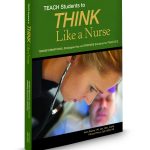
When I began my journey to become a nurse educator, I started out as a part-time clinical adjunct for a local nursing program.
Though I was proficient and experienced as a nurse in clinical practice for over twenty years, I quickly realized that I was utterly unprepared for this entirely different scope of practice.
Mentoring and teaching a new nurse in the clinical setting in no way compares to managing 8 to 10 students as a clinical educator!
I quickly realized that though a nurse may be a clinical expert in his/her respective clinical specialty, it is no guarantee they can effectively communicate that professional knowledge and skills to students in the clinical setting.
Novice to Expert Applied to Educators
Patricia Benner’s (Benner, 1982) novice to expert theory recognized that it took two to three years for a new novice nurse to become competent or proficient in clinical practice. This principle also applies to new nurse educators. What is a hallmark trait of novice nursing students?
They are TASK oriented and focus on what needs to get done and lose sight of the patient.
As I look back, I too was task-oriented as a new clinical educator and focused on how many procedures or medications could be done in a sheet clinical shift, while minimizing or not having the time to develop nurse thinking.
If possible, everybody passed meds, and if a student was able to insert a Foley catheter and another got to insert a nasogastric tube that was a perfect clinical day. (though it left me exhausted!)
Is there a better way?
As I grew as an educator over time, I began to make the transition from emphasizing the TASKS to developing the THINKING.
So what do the best clinical nurse educators have in common?
In a timeless journal article, Nehring (1990) identified seven habits or traits that students are needing and looking for in a clinical educator.
Principles to Prepare the Way
As a parent of five children who are now grown, I have recognized that there are numerous parallels between being a parent and an effective nurse educator.
This includes having high but realistic expectations, the importance of setting defined boundaries, following through with clearly communicated consequences when those boundaries were crossed, and the power of positive role modeling by your lived example.
Nehring (1990) validated this same observation over twenty years ago. She identified that from a student’s perspective, the lived example of an educator who is a good role model as a professional nurse is an essential characteristic that distinguishes the best from the worst rated clinical faculty.
Let’s take a closer look at each of the most important traits in the order they were rated by students. Make it a priority to cultivate these habits in your clinical setting to strengthen your effectiveness as a clinical educator.
Habit #1. Good role model
What is your example communicating? Are you living out to your students and colleagues the values and ethics of the nursing profession that include caring, compassion, and respect consistently in all that you do?
If there is a lack of integrity demonstrated by faculty due to an inconsistency between what is taught and lived out, students will readily recognize it and are more likely to model what they see lived out.
Tanner (1990) recognized the power of the “hidden curriculum.” It is not what is in the syllabus that students learn, but the values and example that are role-modeled to students that influence the formative development of students.
What are your students learning in your program?
Habit #2. Enjoys nursing & teaching
As I look back at nurse educators who impacted me the most in nursing education, it was those that had an evident passion and love for nursing as a profession and enjoyed working with students and teaching the craft.
This passion is contagious.
Though nursing academia can be stressful and at times joy-stealing, do you still have the joy and genuinely enjoy what you do, or are you emotionally and physically exhausted and in need of a break to counter early burnout?
Habit #3. Well prepared
I think it is essential to see this value from a student’s perspective.
What is communicated nonverbally when an educator comes to class or clinical NOT prepared?
An educator can appear incompetent and unprofessional as a result. It tends to decrease student confidence in the ability of an educator especially if it is a pattern. Make it a priority to do what is needed to prepare for the unexpected in academia.
It tends to decrease student confidence in the ability of an educator especially if it is a pattern. Make it a priority to do what is needed to be prepared for the unexpected in academia and roll with the changes. I have found that my ED clinical experience prepared me well for the challenges in nursing education.
Habit #4. Clinically excellent
This ties in closely with the importance of being an excellent role model. When you as a clinical educator demonstrate excellence, you become an example you want your students to become.
Make it a priority to maintain currency in clinical practice in some way.
If you are a full-time faculty, who is unable to remain current in clinical practice by working in the clinical setting, make it a priority to stay current in the literature and best practice in your setting so that this excellence and knowledge is communicated to students.
They recognize the difference and need your salience.
Habit #5. Approachable
Do everything possible to be approachable to students so that they are comfortable coming to you with any questions they may have.
This is why it is so important to create a safe environment for students to ask questions in the clinical setting.
When this is intentionally demonstrated and communicated by faculty, student learning is strengthened.
Habit #6. Encourages mutual respect
When an attitude and culture of honor is given by the educator towards students, respect will be reciprocated to the educator.
But if an educator is rigid, antagonistic or demonstrates other attitudes of disrespect to students, disrespect will be returned. Clark (2008) identified this lived reality as a “dance” where one attitude leads and the same will readily follow.
Another analogy that demonstrates this truth is the biblical principle of “sowing and reaping.” Whatever we sow, we will also reap” (Galatians 6:7).
Habit #7. Provides support & encouragement
Students are stressed and in need of continual encouragement.
Most students are high achievers who feel the burn of nursing education and over time can begin to feel like a failure if they are unable to maintain the high GPA and expectations they have that define academic success.
Think of students as sponges.
They will readily soak up your knowledge that you can impart and share in the clinical setting as well as your praise and encouragement!
Look for the good, be generous with praise and encouragement and your students will appreciate the needed support!
ACTION Step
As you review these seven traits that the best clinical educators have in common, pause and honestly reflect.
What are your strengths? What are your current weaknesses?
Write them down.
Then make it a priority to address any weaknesses as part of your action and growth plan as a clinical nurse educator and make it a strength by the end of the semester.
In Closing
Adopt the motto of the Home Depot as a nurse educator…NEVER STOP IMPROVING!
Regardless of your years of experience, never settle, but determine to be the best and pursue excellence in all that you do in nursing education.
You have great power to impact the next generation of caregivers directly.
Therefore, resolve to do what is needed to make any weakness a strength, and you will make a difference by better preparing students for clinical practice!
Comment Question:
What traits do you feel are most important as a clinical educator? What else would you would add to this list?
Comment below and let the conversation begin!
Want More on Clinical Education?
Here are some recent blogs that you may have missed to strengthen clinical teaching!
- Why Nursing Process Can Be a Barrier to Develop a Student’s Ability to Think Like a Nurse
- Strengthen Your Clinical Teaching with these 4 Simple Strategies!
- How to Help Students Set Correct Priorities in the Clinical Setting
References
- Benner, P. (1982). From novice to expert. American Journal of Nursing, 82(3), 402–407.
- Clark, C.M. (2008). The dance of incivility in nursing education as described by nursing faculty and students, Advances in Nursing Science, 31, E37-E54.
- Nehring, V. (1990). Nursing clinical teacher effectiveness inventory: A replication study of ‘best’ and ‘worst’ clinical teachers as perceived by nursing faculty and students, Journal of Advanced Nursing, 15, 934-940.
- Tanner, C.A. (1990). Caring as a value in nursing education, Nursing Outlook, 38(2), 70-72
A New Resource to Help Nurse Educators
There is no such thing as a born nurse educator. It takes time and implementing educational best practice in your program.
Today’s blog came from my new text for educators TEACH Students to THINK Like a Nurse.
Numerous best-practice strategies and time-saving tools to strengthen both classroom and clinical learning!
Keith Rischer – PhD, RN, CEN
As a nurse with over 35 years of experience who remained in practice as an educator, I’ve witnessed the gap between how nursing is taught and how it is practiced, and I decided to do something about it! Read more…
The Ultimate Solution to Develop Clinical Judgment Skills
KeithRN’s Think Like a Nurse Membership
Access exclusive active learning resources for faculty and students, including KeithRN Case Studies, making it your go-to resource.




